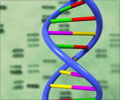Cells that can count and remember cellular events have been designed by MIT and Boston University engineers
Cells that can count and "remember" cellular events have been designed by MIT and Boston University engineers. They used simple circuits in which a series of genes are activated in a specific order.
Such circuits, which mimic those found on computer chips, could be used to count the number of times a cell divides, or to study a sequence of developmental stages. They could also serve as biosensors that count exposures to different toxins.The team developed two types of cellular counters, both described in the May 29 issue of Science. Though the cellular circuits resemble computer circuits, the researchers are not trying to create tiny living computers.
"I don't think computational circuits in biology will ever match what we can do with a computer," said Timothy Lu, a graduate student in the Harvard-MIT Division of Health Sciences and Technology (HST) and one of two lead authors of the paper.
Performing very elaborate computing inside cells would be extremely difficult because living cells are much harder to control than silicon chips. Instead, the researchers are focusing on designing small circuit components to accomplish specific tasks.
"Our goal is to build simple design tools that perform some aspect of cellular function," said Lu.
Ari Friedland, a graduate student at Boston University, is also a lead author of the Science paper. Other authors are Xiao Wang, postdoctoral associate at BU; David Shi, BU undergraduate; George Church, faculty member at Harvard Medical School and HST; and James Collins, professor of biomedical engineering at BU.
Advertisement
To demonstrate their concept, the team built circuits that count up to three cellular events, but in theory, the counters could go much higher.
Advertisement
With the first stimulus — for example, an influx of sugar into the cell — the cell produces the first protein in the sequence, an RNA polymerase (an enzyme that controls transcription of another gene). During the second influx, the first RNA polymerase initiates production of the second protein, a different RNA polymerase.
The number of steps in the sequence is, in theory, limited only by the number of distinct bacterial RNA polymerases. "Our goal is to use a library of these genes to create larger and larger cascades," said Lu.
The counter's timescale is minutes or hours, making it suitable for keeping track of cell divisions. Such a counter would be potentially useful in studies of aging.
The RTC Counter can be "reset" to start counting the same series over again, but it has no way to "remember" what it has counted. The team's second counter, called the DIC (DNA Invertase Cascade) Counter, can encode digital memory, storing a series of "bits" of information.
The process relies on an enzyme known as invertase, which chops out a specific section of double-stranded DNA, flips it over and re-inserts it, altering the sequence in a predictable way.
The DIC Counter consists of a series of DNA sequences. Each sequence includes a gene for a different invertase enzyme. When the first activation occurs, the first invertase gene is transcribed and assembled. It then binds the DNA and flips it over, ending its own transcription and setting up the gene for the second invertase to be transcribed next.
When the second stimulus is received, the cycle repeats: The second invertase is produced, then flips the DNA, setting up the third invertase gene for transcription. The output of the system can be determined when an output gene, such as the gene for green fluorescent protein, is inserted into the cascade and is produced after a certain number of inputs or by sequencing the cell's DNA.
This circuit could in theory go up to 100 steps (the number of different invertases that have been identified). Because it tracks a specific sequence of stimuli, such a counter could be useful for studying the unfolding of events that occur during embryonic development, said Lu.
Other potential applications include programming cells to act as environmental sensors for pollutants such as arsenic. Engineers would also be able to specify the length of time an input needs to be present to be counted, and the length of time that can fall between two inputs so they are counted as two events instead of one.
They could also design the cells to die after a certain number of cell divisions or night-day cycles.
"There's a lot of concern about engineered organisms — if you put them in the environment, what will happen?" said Collins, who is also a Howard Hughes Medical Institute investigator. These counters "could serve as a programmed expiration date for engineered organisms."
Source-Eurekalert
RAS









